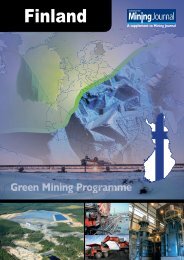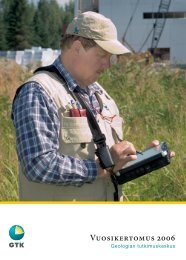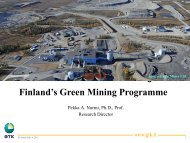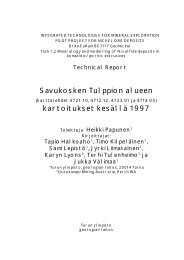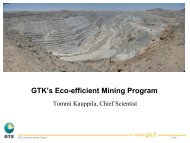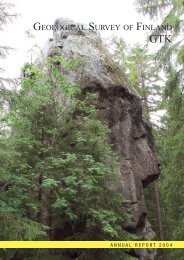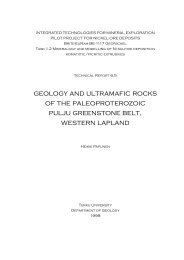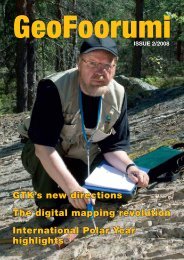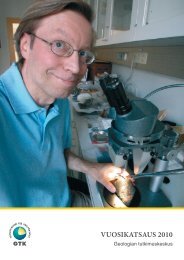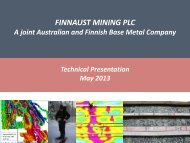Competitive Edge of the Finnish Mineral Cluster - Finstone
Competitive Edge of the Finnish Mineral Cluster - Finstone
Competitive Edge of the Finnish Mineral Cluster - Finstone
You also want an ePaper? Increase the reach of your titles
YUMPU automatically turns print PDFs into web optimized ePapers that Google loves.
<strong>Competitive</strong> <strong>Edge</strong> <strong>of</strong> <strong>the</strong><br />
<strong>Finnish</strong> <strong>Mineral</strong> <strong>Cluster</strong><br />
Helsinki, November 2011
Recently Kaivokset opened ja ajankohtaiset mines and current tutkimuskohteet<br />
projects in Finland (September Active 2011) Mines and Current Projects<br />
Syyskuu 2011 September 2011<br />
Jalometallit<br />
1. Iso-Kuotko gold - Agnico-Eagle Ltd<br />
2. Hanhimaa gold - Dragon Mining Ltd<br />
3. Kittilä gold - Agnico-Eagle Ltd<br />
4. Kettukuusikko gold - Taranis Resources Inc.<br />
5. Naakenavaara gold - Taranis Resources Inc.<br />
6. Pahtavaara gold - Lappland Goldminers Ab<br />
7. Kiekerömaa gold - Tertiary <strong>Mineral</strong>s Plc<br />
8. Suhanko-Konttijärvi PGE - Gold Fields Arctic Platinum Oy<br />
9. Kuusamo gold - Dragon Mining Ltd<br />
10. Laiva gold - Nordic Mines Ab<br />
11. Hirsikangas gold - Belvedere Resources Finland Oy<br />
12. Kopsa gold - Belvedere Mining Oy<br />
13. Taivaljärvi silver - Sotkamo Silver AB<br />
14. Seinäjoki gold, antimony - Nortec <strong>Mineral</strong>s Corp.<br />
15. Pampalo gold - Endomines AB<br />
16. Osikonmäki gold - Belvedere Resources Finland Oy<br />
17. Haveri gold - Lappland Goldminers Ab<br />
18. Orivesi gold - Dragon Mining Ltd<br />
19. Jokisivu gold - Dragon Mining Ltd<br />
20. Kaapelinkulma gold - Dragon Mining Ltd<br />
Perusmetallit<br />
1. Riikonkoski copper, gold - Taranis Resources Inc.<br />
2. Kevitsa nickel, copper, PGE - First Quantum <strong>Mineral</strong>s Ltd<br />
3. Sodankylä nickel, copper - Anglo American Exploration B.V.<br />
4. Kaukua nickel, PGE - Nortec <strong>Mineral</strong>s Corp.<br />
5. Kuhmo nickel - Altona Mining Ltd<br />
6. Kuhmo nickel - Anglo American Exploration B.V.<br />
7. Talvivaara nickel, zinc, copper - Talvivaara Mining Co.<br />
8. Hitura nickel - Belvedere Mining Oy<br />
9. Pyhäsalmi zinc, copper, pyrite - Inmet Mining Corp.<br />
10. Rautavaara nickel, zinc, copper -<br />
Western Areas NL & Magnus <strong>Mineral</strong>s Oy JV<br />
11. Kylylahti copper, gold, zinc, nickel, cobalt - Altona Mining Ltd<br />
12. Valkeisenranta, Särkiniemi nickel, copper - Altona Mining Ltd<br />
Timantti<br />
1. Kuusamo - Sunrise Resources Plc<br />
2. Kuhmo - Karelian Diamond Resources Plc<br />
3. Kaavi-Kuopio - Sunrise Resources Plc<br />
4. Kaavi - Mantle Diamonds Ltd &<br />
Firestone Diamonds Developments JV<br />
Muut<br />
Precious Metals<br />
Base Metals<br />
Diamond<br />
O<strong>the</strong>r Commodities<br />
1. Sokli phosphorus, niobium - Yara International ASA<br />
2. Sivakkalehto iron - Tertiary <strong>Mineral</strong>s Plc<br />
3. Kolari iron, gold, copper - Northland Resources Ab<br />
4. Rompas gold, uranium - Mawson Resources Ltd<br />
5. Ranua uranium - Mawson Resources Ltd<br />
6. Mustavaara vanadium - Mustavaaran Kaivos Oy<br />
7. Kemi chromium - Outokumpu Chrome Oy<br />
8. Punasuo talc, nickel - Mondo <strong>Mineral</strong>s Oy<br />
9. Alanen talc - Talc de Luzenac<br />
10. Länttä lithium - Keliber Resources Ltd<br />
11. Koivusaarenneva ilmenite - Kalvinit Oy<br />
12. Siilinjärvi phosphorus - Yara International ASA<br />
13. Eno uranium - Mawson Resources Ltd<br />
14. Tammela lithium, tin, tantalum - Nortec <strong>Mineral</strong>s Corp.<br />
17<br />
11<br />
19<br />
2<br />
3<br />
2<br />
3<br />
10<br />
14<br />
18<br />
11<br />
14<br />
Kaivos<br />
Mine<br />
4<br />
8<br />
20<br />
4<br />
1<br />
2<br />
5 6<br />
7<br />
8<br />
10<br />
7<br />
Tutkimuskohde<br />
Prospect<br />
1<br />
3<br />
12<br />
9<br />
5<br />
12<br />
2<br />
12<br />
3<br />
6<br />
8<br />
9<br />
10<br />
16<br />
1<br />
4<br />
5<br />
6<br />
7<br />
1<br />
3<br />
11<br />
9<br />
2<br />
4<br />
13<br />
15<br />
13<br />
0 50 100<br />
km<br />
Valtaustilanne 29.6.2011<br />
Land Tenure 29 June 2011<br />
Kaivospiiri<br />
Mining Concession<br />
Valtaus<br />
Claim<br />
Varaus<br />
Claim Reservation<br />
Source: GTK.
<strong>Competitive</strong> <strong>Edge</strong> <strong>of</strong> <strong>the</strong> <strong>Finnish</strong> <strong>Mineral</strong> <strong>Cluster</strong><br />
The competitiveness and economic impacts <strong>of</strong> <strong>the</strong> <strong>Finnish</strong> mineral cluster were evaluated in a research project conducted<br />
by ETLA, <strong>the</strong> Research Institute <strong>of</strong> <strong>the</strong> <strong>Finnish</strong> Economy, during 2010–2011. This is an English summary <strong>of</strong> <strong>the</strong> study.<br />
The study was published in <strong>Finnish</strong> by <strong>the</strong> name “Kalliosta kullaksi – kummusta klusteriksi, Suomen mineraaliklusterin<br />
vaikuttavuusselvitys” ETLA B 252, Helsinki 2011 http://www.etla.fi/julkaisuhaku.phptype=details&id=1827<br />
The <strong>Finnish</strong> mineral cluster is comprised <strong>of</strong> three extractive<br />
sectors – <strong>the</strong> mining industry, aggregates industry<br />
and <strong>the</strong> natural stone industry. In addition, <strong>the</strong><br />
cluster includes diverse fields <strong>of</strong> technology manufacturing<br />
– manufacture <strong>of</strong> mining machinery, rock crushing<br />
equipment and enrichment equipment – and process<br />
suppliers. The activities <strong>of</strong> <strong>the</strong> mining industry are<br />
based upon large-scale geological mapping and research.<br />
Their results are utilized by <strong>the</strong> so-called mining<br />
development companies, which are internationally<br />
called junior companies. They investigate promising<br />
deposits and develop <strong>the</strong>m into mining sites that can<br />
attract investment. The same functions are also needed<br />
for development <strong>of</strong> deposits <strong>of</strong> aggregates and natural<br />
stones. Many new industries emerge from <strong>the</strong> cluster,<br />
such as exploration-stage drilling companies and assorted<br />
contractors that drill, explode and crush aggregates<br />
or shape rock slabs and provide transport services<br />
at mines, excavation sites and natural stone quarries.<br />
Jobs for 50 000 people<br />
The mineral cluster as a whole employs more than<br />
16,200 people, and employment will increase by middecade<br />
to about 20,000 people in <strong>the</strong> wake <strong>of</strong> growth<br />
in mining activities. When <strong>the</strong> foreign staff <strong>of</strong> equipment<br />
manufacturers is taken into account, <strong>the</strong> cluster<br />
directly employs 32,500 people. Including <strong>the</strong> multiplier<br />
effect on employment in Finland, <strong>the</strong> cluster employs<br />
25,000 people, and if foreign operations are included<br />
<strong>the</strong> number <strong>of</strong> jobs rises to 50,000 people.<br />
Like <strong>the</strong> forest industry and telephone operator activities,<br />
<strong>the</strong> mining cluster has given rise to significant tech-<br />
Bolting machine in Pyhäsalmi mine<br />
Photo: Pyhäsalmi Mine Oy.
nology manufacturing. <strong>Finnish</strong> companies engaged in<br />
<strong>the</strong> manufacturing technology <strong>of</strong> mineral cluster have<br />
become very international. The companies have sales<br />
and service points as well as production located on all<br />
continents and in major mining countries.<br />
The most significant impact on <strong>the</strong> <strong>Finnish</strong> economy<br />
has been <strong>the</strong> raw material base <strong>of</strong>fered by <strong>the</strong> mineral<br />
cluster. The mines gave birth to metal processing and<br />
manufacturing <strong>of</strong> versatile chemical and mineral products.<br />
The most important raw materials used in construction<br />
are various sorts <strong>of</strong> aggregates: sand, gravel<br />
and crushed. Natural stone is processed fur<strong>the</strong>r for<br />
construction purposes, fireplaces, monuments and <strong>the</strong><br />
o<strong>the</strong>r stone products. Industry using minerals as a raw<br />
material employs over a quarter <strong>of</strong> a million people in<br />
Finland.<br />
Safe and effective business environment<br />
Compared to any o<strong>the</strong>r country, <strong>the</strong> mineral cluster in<br />
Finland can be regarded as very advanced for <strong>the</strong> following<br />
reasons:<br />
• There are good mineral and stone resources that<br />
companies are able to utilize safely and sustainably.<br />
Developed infrastructure supports <strong>the</strong> operations.<br />
• In addition to extraction activities, <strong>the</strong> cluster has<br />
developed versatile refinement processes. Only a<br />
fraction <strong>of</strong> <strong>the</strong> extractive industry’s products are exported<br />
unprocessed.<br />
• The extractive industry has given rise to diverse<br />
technology manufacturers dominating international<br />
markets as in o<strong>the</strong>r major clusters (forest cluster<br />
and ICT cluster).<br />
• The extractive industry in Finland has been a pioneer<br />
in safety and environmental thinking.<br />
• The next stage <strong>of</strong> development will be <strong>the</strong> emergence<br />
<strong>of</strong> a wide range <strong>of</strong> services and <strong>the</strong>ir globalization.<br />
• In Finland, current trends include development <strong>of</strong><br />
training in this field and investment in innovation<br />
activities.<br />
Future – Over 40 new mines<br />
In recent years, <strong>the</strong> biggest mining investments have<br />
been <strong>the</strong> Talvivaara multi-metal mine (production began<br />
in 2009) and <strong>the</strong> Kittilä gold mine (2009). The planning<br />
for expansion <strong>of</strong> both <strong>of</strong> <strong>the</strong>se mines is already under<br />
way. These mines quickly grew right from <strong>the</strong> start<br />
<strong>of</strong> <strong>the</strong>ir production to be amongst <strong>the</strong> largest in Finland,<br />
alongside Pyhäsalmi, Kemi and Siilinjärvi. In addition,<br />
<strong>the</strong> Kevitsa multi-metal mine is currently under<br />
construction (2012) with expansions being planned.<br />
The expansion <strong>of</strong> <strong>the</strong> Kemi mine will double its production<br />
capacity. The Hitura nickel-copper mine has been<br />
re-opened. The Pampalo gold mine began production<br />
in <strong>the</strong> spring <strong>of</strong> 2011 and <strong>the</strong> Laiva gold mine will<br />
start up in late 2011. Big mines in terms <strong>of</strong> mining volume<br />
in <strong>the</strong> future will be <strong>the</strong> Kolari iron mine and <strong>the</strong><br />
Sokli phosphorus mine. In addition, data is expected<br />
from Anglo American’s promising research work in Sodankylä<br />
and from <strong>the</strong> Ranua palladium and platinum<br />
mines. All in all <strong>the</strong>re are over 40 new mining projects<br />
and development sites in Finland.<br />
Structure <strong>of</strong> <strong>Finnish</strong> mineral cluster<br />
Special inputs<br />
• Location and Infra<br />
• <strong>Mineral</strong> resources<br />
• Geological data<br />
Technology<br />
• Mining machineries<br />
• Enrichment technology<br />
• Stone processing machines<br />
• ICT<br />
• Environmental expertise<br />
Associated services<br />
• Exploration and junior<br />
companies<br />
• R&D and education<br />
• Financing<br />
Primary goods<br />
• Ores and<br />
concentrates<br />
• Industrial minerals<br />
• Aggregates<br />
• Natural stones and<br />
stone products<br />
Related industries<br />
• Excavation contractor<br />
• Transport<br />
• Rock engineering<br />
• Design and architecture<br />
• Energy production<br />
• Residential services<br />
Consumers<br />
• Basic metal industries<br />
• Chemical industry<br />
• Construction materials<br />
industry<br />
• Construction
Mining revolution in Kittilä<br />
The 8th Fennoscandian Exploration and Mining<br />
Conference was held at <strong>the</strong> Levi Summit Conference<br />
Centre located in <strong>the</strong> municipality <strong>of</strong> Kittila.<br />
Kittila has thrived on tourism. Levi is Finland’s largest<br />
ski resort in terms <strong>of</strong> sales. Kittilä has 22,000<br />
beds for tourists and an airport. Agnico-Eagle Finland’s<br />
mine at Kittilä started production in 2008.<br />
It is Europe’s largest mine exclusively focused on<br />
<strong>the</strong> excavation <strong>of</strong> gold. What has happened to <strong>the</strong><br />
economy in <strong>the</strong> local municipality <strong>of</strong> Kittilä<br />
The economy is now strong, because <strong>the</strong> municipality<br />
has two pillars: tourism and mining. Tourism<br />
provides about 1,100 jobs. The mine employed<br />
591 people at <strong>the</strong> end <strong>of</strong> 2010. The unemployment<br />
rate <strong>of</strong> in municipality has fallen below<br />
10 per cent, to 6 per cent during <strong>the</strong> high tourist<br />
season. Unemployment was 21% in <strong>the</strong> year 2000<br />
and nearly 14% in 2006 when construction <strong>of</strong> <strong>the</strong><br />
mine began.<br />
Kittilä’s mine has an annual turnover <strong>of</strong> approximately<br />
EUR 150 million. Tourism generates income<br />
<strong>of</strong> 200 million euros. Kittilä’s mine is planned<br />
to be expanded in <strong>the</strong> future. Mining operations<br />
should become a more important source <strong>of</strong> revenue<br />
than tourism.<br />
Kittilä’s mine accounted for about 3.5 million <strong>of</strong><br />
municipal tax revenues in 2010, while <strong>the</strong> central<br />
government received <strong>the</strong> same amount <strong>of</strong> tax revenues.<br />
The mine paid 200,000 euros in real estate<br />
taxes to <strong>the</strong> municipality. The central government<br />
will also receive 2 million euros in royalties from<br />
mineral rights. The corporate income tax paid by<br />
<strong>the</strong> mine is expected to rise in <strong>the</strong> future to 10–15<br />
million euros.<br />
Sources: Agnigo Eagle Finland Oy and Kittilä municipality,<br />
www.kittila.fi<br />
Multipler income effects <strong>of</strong> a mining job are<br />
greater than those <strong>of</strong> a person catering to tourists.<br />
When <strong>the</strong> multiplier effects are taken into account,<br />
Kittilä’s tourism employs about 1,650 people<br />
while mining employs 1,350. Population <strong>of</strong><br />
Kittilä has also begun to increase, it exceeded <strong>the</strong><br />
limit <strong>of</strong> 6,000 inhabitants.<br />
Investments 3 billion euros<br />
Mining investments required over <strong>the</strong> next few years<br />
are projected to be at least 1.6 billion euros, calculated<br />
based on projects for which companies have announced<br />
<strong>the</strong> sums to be invested. This figure includes<br />
investments required by mine construction in construction,<br />
machinery and equipment as well as immediate<br />
mine-related infrastructure. In reality, we expect<br />
investments to rise to about 3 billion euros, taking into<br />
account earlier investments in <strong>the</strong> Talvivaara mines and<br />
<strong>the</strong> almost certain to be realized production expansion<br />
<strong>of</strong> <strong>the</strong> Kevitsa, Kittilä and Talvivaara mines. These investment<br />
costs do not include public investments in infrastructure,<br />
which can be very sizeable, for instance, if<br />
<strong>the</strong>y require new tracks.<br />
Real mining boom<br />
According to a survey conducted by ETLA, <strong>the</strong> Research<br />
Institute <strong>of</strong> <strong>the</strong> <strong>Finnish</strong> Economy:<br />
• Extraction volumes were 54 million tonnes in 2009.<br />
Extraction will increase by nearly three-fold to approximately<br />
155 million tonnes by 2016. Ore mining<br />
will increase by 24 million tonnes to a maximum <strong>of</strong><br />
68 million tonnes. These figures include quarrying<br />
<strong>of</strong> both metal ores and non-metallic minerals. In <strong>the</strong><br />
beginning <strong>of</strong> <strong>the</strong> millennium ore mining was only 4<br />
million tonnes. At <strong>the</strong> end <strong>of</strong> this decade we expect<br />
that ore mining will rise up to 100 million tonnes.<br />
• In 2010 mining companies reported <strong>the</strong>y employed<br />
about 3,000 people, including <strong>the</strong>ir own personnel<br />
and subcontractors. According to a survey, mining<br />
will employ as many as 5,200 people in <strong>the</strong> next decade.<br />
In addition, construction <strong>of</strong> mines will create<br />
jobs.
Fast growing Paakkola Conveyors<br />
Paakkola Conveyors Ltd is a fast growing technology company supplying conveyor systems. The starting<br />
point for operations is to solve <strong>the</strong> objectives <strong>of</strong> a project in close collaboration with <strong>the</strong> client. The company<br />
has 30 years <strong>of</strong> experience in supplying conveyors for demanding Nordic conditions in <strong>Finnish</strong>, Swedish,<br />
Norwegian and Russian mines and industries. The mining boom has helped <strong>the</strong> company to achieve<br />
strong growth.<br />
The company won <strong>the</strong> tender for <strong>the</strong> Talvivaara mine conveyor project. The firms in <strong>the</strong> running for <strong>the</strong><br />
tender included top international competitors. The value <strong>of</strong> <strong>the</strong> project was some 24 million euros. It included<br />
6 kilometres <strong>of</strong> overland conveyor tracks and a 420 metre long bridge stacker conveyor. The bridge<br />
stacker conveyor is mounted on 9 crawler units steered with a GPS positioning system. The equipment has<br />
a capacity <strong>of</strong> 4,500 tonnes per hour.<br />
After <strong>the</strong> Talvivaara project, Paakkola Conveyors also won <strong>the</strong> tenders for Kevitsa and Kemi mine conveyors.<br />
The company delivered 11 conveyors to <strong>the</strong> Kevitsa mineral processing plant owned by First Quantum<br />
<strong>Mineral</strong>s Ltd. The conveyors have a capacity <strong>of</strong> 200–2,000 tonnes per hour and a total length <strong>of</strong> 1.8 kilometres.<br />
Paakkola Conveyors is supplying a homogenization and conveyor system for intermediate stockpiling<br />
<strong>of</strong> crushed ore for <strong>the</strong> Outokumpu Chrome Oyj, Kemi mine. According to Managing Director Tommi<br />
Juntikka <strong>the</strong>ir automatic homogenization system is a considerable step towards becoming a specialized<br />
international supplier <strong>of</strong> demanding conveyor systems.<br />
Paakkola Conveyors’ turnover and number <strong>of</strong> employees<br />
80<br />
70<br />
60<br />
50<br />
40<br />
30<br />
20<br />
10<br />
Number <strong>of</strong> employees (left-hand scale)<br />
Turnover, million euros (right-hand scale)<br />
35<br />
30<br />
25<br />
20<br />
15<br />
10<br />
5<br />
0<br />
2005 2006 2007 2008 2009 2010<br />
0<br />
Sources: Juntikka Tommi, Paakkola Conveyors Oy.
• Turnover from mining activities, which describes<br />
<strong>the</strong> value <strong>of</strong> production, will increase from slightly<br />
less than 800 million euros in 2010 to an estimated<br />
2.5 billion euros by <strong>the</strong> middle <strong>of</strong> <strong>the</strong> decade.<br />
In reality, production volumes, turnover and number <strong>of</strong><br />
employees will rise above <strong>the</strong>se figures if <strong>the</strong> world market<br />
prices <strong>of</strong> ore and industrial minerals remain high as<br />
expected. Thus research on mineral deposits and <strong>the</strong>ir<br />
development into mines will continue to be brisk in <strong>the</strong><br />
next decade.<br />
<strong>Mineral</strong> cluster benefits all <strong>of</strong> Finland<br />
Mining jobs are located mostly in nor<strong>the</strong>rn and eastern<br />
Finland. O<strong>the</strong>r major beneficiaries are <strong>the</strong> provinces<br />
<strong>of</strong> Nor<strong>the</strong>rn Karelia and Nor<strong>the</strong>rn Ostrobothnia.<br />
Mines are creating jobs in areas which currently have<br />
<strong>the</strong> highest unemployment. The employment effects <strong>of</strong><br />
mining are felt throughout <strong>the</strong> country.<br />
The manufacturing <strong>of</strong> equipment for mining technology<br />
employs mechanical industry cities like Tampere,<br />
Turku, Pori, Lappeenranta and Iisalmi. Through subcontracting<br />
<strong>the</strong> effects extend to <strong>the</strong> whole country.<br />
Metal processing is concentrated in <strong>the</strong> coastal towns<br />
<strong>of</strong> <strong>the</strong> Gulf <strong>of</strong> Bothnia and Gulf <strong>of</strong> Finland, where lowcost<br />
sea transportation may be utilized.<br />
The aggregates industry is located all over <strong>the</strong> country,<br />
because all construction and maintenance <strong>of</strong> <strong>the</strong> built<br />
environment is based on <strong>the</strong> ready availability <strong>of</strong> different<br />
types <strong>of</strong> mineral products. Aggregates production<br />
volumes correspond regionally to infrastructural<br />
and residential construction. If aggregates excavation<br />
and processing activities are located far away from <strong>the</strong><br />
construction sites, this significantly increases <strong>the</strong> total<br />
construction costs since about half <strong>the</strong> price <strong>of</strong> aggregates<br />
on site consists <strong>of</strong> transportation costs. The main<br />
aggregate processing areas are <strong>the</strong> greater Helsinki region<br />
and <strong>the</strong> regions <strong>of</strong> Pirkanmaa, Turku, Oulu and<br />
Jyväskylä.<br />
The natural stone industry centres are Sou<strong>the</strong>rn Karelia,<br />
and Kymenlaakso as well as Southwestern Finland,<br />
Häme and Uusimaa with its granite reserves, and<br />
Nor<strong>the</strong>rn Karelia with its soapstone industry.<br />
Extractive industries are enabling industries. Ores are<br />
fur<strong>the</strong>r processed in Finland, and <strong>the</strong> vast majority <strong>of</strong><br />
products will be exported. Aggregates are <strong>the</strong> most important<br />
raw material for <strong>the</strong> job-creating construction<br />
industry. The processing chains <strong>of</strong> <strong>the</strong> natural stone industry<br />
extend around <strong>the</strong> world.<br />
New mines – Progress for Lapland’s and<br />
Kainuu’s economy<br />
Input-output analysis was used to examine <strong>the</strong> effects<br />
<strong>of</strong> four mining investments in Lapland (Hannukainen,<br />
Kevitsa and Suurkuusikko mines as well as Outokumpu’s<br />
mine and expansion <strong>of</strong> ferrochrome production)<br />
in addition to those <strong>of</strong> Talvivaara in Kainuu and<br />
<strong>the</strong> Taivalhopea mine to be opened in 2013.<br />
• The direct output impact <strong>of</strong> growth in mining activities<br />
in Lapland at <strong>the</strong> end <strong>of</strong> <strong>the</strong> decade will be<br />
almost 600 million euros annually. Taking into account<br />
<strong>the</strong> indirect effects, <strong>the</strong> output <strong>of</strong> <strong>the</strong> Province<br />
<strong>of</strong> Lapland will increase by an estimated 1.2 billion<br />
euros. The impact on employment <strong>of</strong> growth in mining<br />
in Lapland will be highest in 2014, when <strong>the</strong> job<br />
increase is about 3,000. One third <strong>of</strong> <strong>the</strong> jobs will be<br />
created directly via quarrying <strong>of</strong> metal ore and mine<br />
construction while two-thirds <strong>of</strong> <strong>the</strong> jobs will be created<br />
in o<strong>the</strong>r industries <strong>of</strong> <strong>the</strong> regional economy.<br />
• The direct impact <strong>of</strong> mines in Kainuu is about 600<br />
million euros while <strong>the</strong> total impact is almost 800<br />
million euros. The total employment impact is about<br />
2,000 jobs and direct employment effect about 600<br />
jobs.<br />
According to input-output analysis, <strong>the</strong> GDP <strong>of</strong> Lapland<br />
would increase by 10 per cent thanks to <strong>the</strong> mines<br />
some <strong>of</strong> which have been decided upon and some <strong>of</strong><br />
which are currently under construction. The GDP <strong>of</strong><br />
Kainuu would increase by as much as 20 per cent because<br />
<strong>the</strong> total output <strong>of</strong> <strong>the</strong> province is o<strong>the</strong>rwise relatively<br />
small.<br />
New development phase<br />
The mining boom has already brought about a new<br />
wave <strong>of</strong> mineral cluster development. Subcontracting<br />
has become a new industry where companies have already<br />
sold <strong>the</strong>ir services to o<strong>the</strong>r countries. A number<br />
<strong>of</strong> mining development companies founded by Finns<br />
are operating in Finland. After a domestic learning period,<br />
<strong>the</strong>se companies will be able to operate in o<strong>the</strong>r<br />
mining countries. Also <strong>the</strong> technology has developed,<br />
as demonstrated e.g. by bioleaching, used in Talvivaara.<br />
New equipment manufacturers have emerged alongside<br />
old ones.<br />
Talvivaara is <strong>the</strong> best example <strong>of</strong> new domestic mining<br />
companies. Normally however, mining development<br />
companies founded by Finns are sold to foreign mining<br />
companies due to lack <strong>of</strong> capital. The establishment <strong>of</strong><br />
a mining investment company and an educational programme<br />
for mining finance can significantly promote<br />
<strong>the</strong> emergence <strong>of</strong> a new domestic mining industry.
Challenges<br />
Mining industry<br />
The operative framework for <strong>the</strong> mining industry was<br />
defined in <strong>the</strong> new Mining Act, which went into force<br />
in summer 2011. The final impact is still difficult to assess,<br />
but conclusions can be drawn on <strong>the</strong> basis <strong>of</strong> <strong>the</strong><br />
new licensing practices that have been applied since<br />
2006. The time it takes to process mining permits has<br />
stretched out to more than two years and <strong>the</strong>re is little<br />
hope for a speedy improvement in <strong>the</strong> situation without<br />
changing <strong>the</strong> law. Companies believe that <strong>the</strong> exploration<br />
and mining compensation stipulated by <strong>the</strong> law is<br />
too high compared to neighbouring countries such as<br />
Sweden. In addition, <strong>the</strong> law increased ra<strong>the</strong>r than decreased<br />
<strong>the</strong> already heavy bureaucracy with respect to<br />
licensing. The Parliamentary Finance Committee said<br />
in its report that superfluous work could be eliminated<br />
by standardizing administrative licensing requirements,<br />
by reducing <strong>the</strong> number <strong>of</strong> individual permits<br />
and making better use <strong>of</strong> information already provided<br />
in o<strong>the</strong>r licensing processes. The mining industry lives<br />
in <strong>the</strong> hope that <strong>the</strong> changes proposed by numerous interest<br />
groups will be implemented by <strong>the</strong> current government.<br />
Mining finance is underdeveloped in Finland, because<br />
previously <strong>the</strong> mines were opened by state-owned companies.<br />
They were able to obtain financing relatively<br />
easily. Today <strong>the</strong> mines are run by private companies<br />
and mining entrepreneurs. The new situation calls for<br />
more funding for mining operations. Nowadays, <strong>the</strong> financing<br />
for projects comes from various stock exchanges<br />
around <strong>the</strong> world and international investors. Efforts<br />
are never<strong>the</strong>less being undertaken to develop domestic<br />
financing channels. Funding is raised from institutional<br />
investors and also <strong>the</strong> government has decided<br />
to invest in mining activities. Some 30 million euros<br />
has been earmarked in <strong>the</strong> central government’s budget<br />
for mining. The government also participates in <strong>the</strong><br />
construction <strong>of</strong> infrastructure and supports technology<br />
development under <strong>the</strong> auspices <strong>of</strong> <strong>the</strong> Green Mining<br />
programme. Mining finance and mining project management<br />
should be developed in Finland in accordance<br />
with <strong>the</strong> best practices in use elsewhere. This will be a<br />
major development project aimed at safeguarding <strong>the</strong><br />
implementation <strong>of</strong> economically viable mining projects<br />
in <strong>the</strong> future. An essential part <strong>of</strong> <strong>the</strong> work entails <strong>the</strong><br />
development <strong>of</strong> teaching about mining finance and reporting<br />
<strong>of</strong> information to investors.<br />
Aggregates production and use per capita is very high in Finland<br />
Aggregates production per capita in tonnes, year 2009<br />
Cyprus<br />
Norway<br />
Finland<br />
Austria<br />
Sweden<br />
Ireland<br />
Belgium<br />
Ne<strong>the</strong>rlands<br />
Germany<br />
Greece<br />
Croatia<br />
Czech Rep<br />
Switzerland<br />
France<br />
Italy<br />
Hungary<br />
Slovakia<br />
Poland<br />
Spain<br />
Denmark<br />
Portugal<br />
Turkey<br />
Bulgaria<br />
UK<br />
Serbia<br />
Romania<br />
0 2 4 6 8 10 12 14 16<br />
Source: UEPG, The European Aggregates Association.
Transport costs are a critical factor in <strong>the</strong> extractive industries<br />
and processing <strong>of</strong> ores:<br />
• New mines need tracks, roads and energy. The government<br />
has responded to <strong>the</strong>se challenges very<br />
well. The principle is that <strong>the</strong> government and <strong>the</strong><br />
mining company agree about <strong>the</strong> investments required.<br />
Investments are first financed by <strong>the</strong> mining<br />
company. If <strong>the</strong> agreed production and transport<br />
volumes are realized, <strong>the</strong> state buys <strong>the</strong> tracks and<br />
roads from <strong>the</strong> company.<br />
• In 2015 stringent sulphur limits will be introduced<br />
on Baltic Sea shipping. Sulphur limits will increase<br />
<strong>the</strong> export costs <strong>of</strong> key client industries – metal<br />
processing and <strong>the</strong> chemical industry – which will<br />
threaten <strong>the</strong>ir competitiveness. Also part <strong>of</strong> <strong>the</strong><br />
mines will need to find low-cost export routes. The<br />
mining industry proposes that a new railway should<br />
be built from <strong>Finnish</strong> Lapland to <strong>the</strong> Arctic Ocean.<br />
This would foster new investments in mining and<br />
processing companies and provide a deep harbour<br />
and low-cost export route to Asia via <strong>the</strong> Arctic<br />
Ocean. The Norwegian and Russian mining industries<br />
are already testing <strong>the</strong> shipping <strong>of</strong> cargo via <strong>the</strong><br />
Arctic route.<br />
Aggregates industry<br />
The excavation sites <strong>of</strong> <strong>the</strong> aggregates industry should<br />
be located close to utilization points because <strong>of</strong> <strong>the</strong><br />
transportation costs. Two-level zoning is proposed as<br />
a solution. Building areas would be zoned for rock material<br />
extraction first, paving <strong>the</strong> way for construction,<br />
and <strong>the</strong>n <strong>the</strong> final purpose.<br />
building life cycle costs as well as technical guidance to<br />
architects and building designers. Real breakthroughs<br />
in exports would apparently also require mergers into<br />
larger companies.<br />
<strong>Mineral</strong> cluster protected by<br />
central government<br />
As a whole, managing <strong>the</strong> natural resource policy and<br />
strategic planning <strong>of</strong> mineral supplies is a challenge for<br />
Finland. An objective was set out in <strong>the</strong> <strong>Mineral</strong> Strategy<br />
document compiled a year ago to streng<strong>the</strong>n <strong>the</strong><br />
position <strong>of</strong> natural resource policy by charging a highlevel<br />
body in <strong>the</strong> central government with responsibility<br />
for <strong>the</strong> overall development and coordination <strong>of</strong> <strong>the</strong><br />
natural resource policy.<br />
Environmental management is a very important aspect<br />
<strong>of</strong> managing natural resources. Society’s sustainable development<br />
is based on three pillars – i.e. environmental,<br />
economic and social perspectives – so that all three<br />
are in balance.<br />
Finland is a world market leader in soapstone<br />
fireplaces<br />
The excavation permits granted to <strong>the</strong> aggregate industry<br />
for sand, gravel and rock are valid for a maximum<br />
<strong>of</strong> 10 years. From <strong>the</strong> standpoint <strong>of</strong> <strong>the</strong> development <strong>of</strong><br />
operations and a positive investment environment <strong>the</strong><br />
new technology would instead require <strong>the</strong> granting <strong>of</strong><br />
permits for several decades.<br />
Natural stone industry<br />
A key objective <strong>of</strong> <strong>the</strong> natural stone industry is to extend<br />
<strong>the</strong> time for extraction to at least <strong>the</strong> 20 years now<br />
allowed by law. It should also be useful to explore systematically<br />
for new rock quarries in order to obtain exportable<br />
production.<br />
The potential export opportunities <strong>of</strong> <strong>the</strong> natural stone<br />
industry are great. Companies in this sector are never<strong>the</strong>less<br />
too small for launching vigorous export efforts,<br />
which is <strong>the</strong> industry’s biggest development challenge.<br />
The companies will work toge<strong>the</strong>r to produce marketing<br />
materials about <strong>the</strong> potential uses <strong>of</strong> natural stone,<br />
Photo: Tulikivi Oyj.
Green Mining Programme<br />
2011–2016<br />
The main objective <strong>of</strong> <strong>the</strong> Green Mining Programme<br />
carried out by Tekes (<strong>the</strong> <strong>Finnish</strong> Funding<br />
Agency for Technology and Innovation) is to<br />
make Finland a global leader <strong>of</strong> <strong>the</strong> sustainable<br />
mineral industry by 2020. The programme creates<br />
new businesses that require new, specialised expertise<br />
alongside <strong>the</strong> growing field <strong>of</strong> traditional<br />
mining. A central goal is to increase <strong>the</strong> number<br />
<strong>of</strong> SMEs geared toward <strong>the</strong> export market in <strong>the</strong><br />
mineral cluster. The programme aims to achieve<br />
global leader status for <strong>the</strong> research in selected<br />
sectors.<br />
The programme consists <strong>of</strong> two main <strong>the</strong>mes:<br />
1) Intelligent and minimum-impact mines<br />
2) New mineral resources<br />
The goal is to invest 60 million euros in development<br />
projects.<br />
The <strong>Finnish</strong> mineral industry is a world leader in<br />
many areas. Equipment and process suppliers in<br />
particular are on <strong>the</strong> leading edge <strong>of</strong> <strong>the</strong> sector<br />
globally. The aim <strong>of</strong> <strong>the</strong> Green Mining Programme<br />
is to make Finland a pioneering country <strong>of</strong> eco-efficiency<br />
in <strong>the</strong> mineral industry by 2020.<br />
”We must capitalise on <strong>the</strong> current growth in <strong>the</strong><br />
mineral industry without wasting time”, stresses<br />
Programme Manager Kari Keskinen from Tekes.<br />
The programme will be promoted through international<br />
networking drawing on best international<br />
practices. The scope <strong>of</strong> this cooperation is a signal<br />
<strong>of</strong> <strong>the</strong> actors’ strong commitment to developing<br />
eco-efficiency.<br />
“The Green Mining Programme <strong>of</strong>fers great opportunities<br />
for stronger internationalisation<br />
through both concrete cooperation projects and<br />
exchanges <strong>of</strong> scientists. This programme will fur<strong>the</strong>r<br />
raise Finland’s pr<strong>of</strong>ile as a country <strong>of</strong> cleantech<br />
expertise”, stresses Chief Technology Officer<br />
Kari Knuutila from Outotec Oyj.<br />
Source: Tekes, http://www.tekes.fi/programmes/<br />
GreenMining<br />
Leading <strong>Finnish</strong> mining technology developers<br />
Metso Materials Inc., http://www.metsomaterialstechnology.com/<br />
Outotec Oyj, http://www.outotec.com<br />
Sandvik Mining and Construction Oy,<br />
http://www.miningandconstruction.sandvik.com/<br />
Kemira Oyj, Mining and Oil and Gas, www.kemira.com/<br />
Normet Oy, http://www.normet.fi/<br />
Forcit Oy, http://www.forcit.fi/en/<br />
Mobile crushing machines are some <strong>of</strong> Finland's successful export products<br />
Photo: Lemminkäinen Infra Oy.
Operating and future mines in Finland
Invest in Finland is <strong>the</strong> government agency promoting foreign<br />
investments into Finland. We assist international companies in<br />
finding business opportunities in Finland and provide all <strong>the</strong> relevant<br />
information and guidance required to establish a business<br />
in Finland. Finland <strong>of</strong>fers significant opportunities in a favourable<br />
mining environment.<br />
www.investinfinland.fi/industries/mining/en_GB/mining/<br />
Tekes – <strong>the</strong> <strong>Finnish</strong> Funding Agency for Technology and Innovation<br />
– is <strong>the</strong> main public funding organisation for research, development<br />
and innovation in Finland. The two principal <strong>the</strong>mes<br />
<strong>of</strong> <strong>the</strong> Green Mining programme are new mineral resources and<br />
intelligent, minimum-impact mining. The programme is intended<br />
not only for mineral sector actors but also for technology industry<br />
companies and service providers supporting <strong>the</strong>m. Both companies<br />
and research institutesare eligible for funding under <strong>the</strong> programme.<br />
www.tekes.fi/programmes/GreenMining<br />
Invest in Finland is <strong>the</strong> government agency promoting foreign<br />
investments into Finland. We assist international companies in<br />
finding business opportunities in Finland and provide all <strong>the</strong><br />
relevant information and guidance required to establish a<br />
business in Finland. Finland <strong>of</strong>fers significant opportunities in a<br />
favourable mining environment.<br />
www.investinfinland.fi/industries/mining/en_GB/mining/<br />
Tekes – <strong>the</strong> <strong>Finnish</strong> Funding Agency for Technology and<br />
Innovation – is <strong>the</strong> main public funding organisation for<br />
research,<br />
Invest<br />
development<br />
in Finland is <strong>the</strong><br />
and<br />
government<br />
innovation<br />
agency<br />
in Finland.<br />
promoting<br />
The two<br />
foreign<br />
principal investments <strong>the</strong>mes into <strong>of</strong> <strong>the</strong> Finland. Green We Mining assist programme international are companies new in<br />
mineral finding ‐impact business mining. opportunities in Finland and provide all <strong>the</strong><br />
The programme relevant information is intended and not guidance only for required mineral to sector establish actors a<br />
but also business for technology in Finland. industry Finland <strong>of</strong>fers companies significant and opportunities service in a<br />
providers favourable supporting mining <strong>the</strong>m. environment. Both companies and research<br />
institutesare www.investinfinland.fi/industries/mining/en_GB/mining/<br />
eligible for funding under <strong>the</strong> programme.<br />
www.tekes.fi/programmes/GreenMining<br />
Tekes – <strong>the</strong> <strong>Finnish</strong> Funding Agency for Technology and<br />
Geological Innovation Survey – is <strong>of</strong> <strong>the</strong> Finland main public (GTK) funding is a state organisation research for institute<br />
under research, Finland´s development Ministry <strong>of</strong> and Employment innovation and in Finland. <strong>the</strong> Economy. The two The<br />
mining principal sector <strong>the</strong>mes forms <strong>the</strong> <strong>of</strong> <strong>the</strong> most Green important Mining programme customer group are new to<br />
which<br />
mineral<br />
GTK provides<br />
‐impact mining.<br />
expert services, geological data bases,<br />
The programme is intended not only for mineral sector actors<br />
identifies areas with mineral potential and finds new surficial<br />
but also for technology industry companies and service<br />
deposits. Fur<strong>the</strong>rmore, GTK <strong>of</strong>fers chemical‐ and mineralprocessing<br />
providers supporting <strong>the</strong>m. Both companies and research<br />
institutesare<br />
services<br />
eligible<br />
and ground‐geophysical<br />
for funding under <strong>the</strong><br />
services<br />
programme.<br />
to <strong>the</strong><br />
sector. www.tekes.fi/programmes/GreenMining<br />
http://en.gtk.fi/<br />
FinnMin Geological ‐ Kaivannaisteollisuus Survey <strong>of</strong> Finland (GTK) ry was is a established state research in institute 1999<br />
to improve under <strong>the</strong> Finland´s operational Ministry environment <strong>of</strong> Employment <strong>of</strong> <strong>the</strong> and <strong>Finnish</strong> <strong>the</strong> Economy. The<br />
extractive mining resources sector forms industry. <strong>the</strong> most Especially important <strong>the</strong> customer metal and group to<br />
industrial which mineral GTK provides mining expert industry services, is <strong>the</strong> geological part <strong>of</strong> industry data bases, which<br />
<strong>the</strong> association identifies areas is serving. with mineral This sector potential is growing and finds very new fast surficial today.<br />
www.kaivannaisteollisuus.fi<br />
deposits. Fur<strong>the</strong>rmore, GTK <strong>of</strong>fers chemical‐ and mineralprocessing<br />
ry on vuonna services 1954 and perustettu ground‐geophysical maa‐ ja vesirakennusalan<br />
services to <strong>the</strong><br />
Infra<br />
sekä asfaltti‐ sector. http://en.gtk.fi/<br />
ja kiviainesalan yritysten etujärjestö ja<br />
työnantajaliitto. FinnMin ‐ Kaivannaisteollisuus Infra ry:n kiviainesjaostoon ry was established järjestäytynyt in 1999<br />
kiviainesteollisuus<br />
to improve <strong>the</strong><br />
tuottaa<br />
operational<br />
kaikessa<br />
environment<br />
rakentamisessa<br />
<strong>of</strong> <strong>the</strong> <strong>Finnish</strong><br />
extractive resources industry. Especially <strong>the</strong> metal and<br />
välttämättömät kiviainekset, eli hiekan, soran ja<br />
industrial mineral mining industry is <strong>the</strong> part <strong>of</strong> industry which<br />
kalliomurskeet. Louhintajaostoon järjestäytynyt<br />
<strong>the</strong> association is serving. This sector is growing very fast today.<br />
louhintatoimiala sisältää kallio‐ ja tunnelirakentamisen<br />
www.kaivannaisteollisuus.fi<br />
yritykset sekä rakentamisessa että kaivos‐, kiviaines‐ ja<br />
Infra ry on vuonna 1954 perustettu maa‐ ja vesirakennusalan<br />
luonnonkiviteollisuudessa sekä asfaltti‐ ja kiviainesalan urakoivat yritysten louhintayritykset.<br />
etujärjestö ja<br />
www.infra.fi työnantajaliitto. Infra ry:n kiviainesjaostoon järjestäytynyt<br />
The <strong>Finnish</strong> kiviainesteollisuus Natural Stone tuottaa Association kaikessa rakentamisessa<br />
was founded in 1938,<br />
and it välttämättömät is <strong>the</strong> only <strong>Finnish</strong> kiviainekset, organization eli hiekan, representing soran ja companies<br />
engaged kalliomurskeet. in <strong>the</strong> field Louhintajaostoon <strong>of</strong> stonework. Member järjestäytynyt companies are<br />
producers louhintatoimiala <strong>of</strong> natural sisältää stones or kallio‐ natural ja tunnelirakentamisen<br />
stone products, and <strong>the</strong><br />
cooperation yritykset members sekä rakentamisessa are companies että kaivos‐, and communities, kiviaines‐ ja such as<br />
research luonnonkiviteollisuudessa and educational institutes, urakoivat that louhintayritykset.<br />
provide <strong>the</strong> stone<br />
industry www.infra.fi with machinery, equipment, supplies and services.<br />
http://finstone.fi/engl/natural_stone.php<br />
The <strong>Finnish</strong> Natural Stone Association was founded in 1938,<br />
and it is <strong>the</strong> only <strong>Finnish</strong> organization representing companies<br />
engaged in <strong>the</strong> field <strong>of</strong> stonework. Member companies are<br />
producers <strong>of</strong> natural stones or natural stone products, and <strong>the</strong><br />
cooperation members are companies and communities, such as<br />
research and educational institutes, that provide <strong>the</strong> stone<br />
industry with machinery, equipment, supplies and services.<br />
http://finstone.fi/engl/natural_stone.php<br />
Geological Survey <strong>of</strong> Finland (GTK) is a state research institute<br />
under Finland´s Ministry <strong>of</strong> Employment and <strong>the</strong> Economy. The<br />
mining sector forms <strong>the</strong> most important customer group to which<br />
GTK provides expert services, geological data bases, identifies areas<br />
with mineral potential and finds new surficial deposits. Fur<strong>the</strong>rmore,<br />
GTK <strong>of</strong>fers chemical- and mineral-processing services<br />
and ground-geophysical services to <strong>the</strong> sector.<br />
http://en.gtk.fi/<br />
FinnMin – Kaivannaisteollisuus ry was established in 1999 to<br />
improve <strong>the</strong> operational environment <strong>of</strong> <strong>the</strong> <strong>Finnish</strong> extractive resources<br />
industry. Especially <strong>the</strong> metal and industrial mineral mining<br />
industry is <strong>the</strong> part <strong>of</strong> industry which <strong>the</strong> association is serving.<br />
This sector is growing very fast today.<br />
www.kaivannaisteollisuus.fi<br />
Infra ry, founded in 1954, functions as <strong>the</strong> federation and employers’<br />
association for civil engineering and <strong>the</strong> asphalt and aggregates<br />
industries. The companies belonging to Infra’s aggregates<br />
industry section produce all sorts <strong>of</strong> aggregates needed in<br />
construction, i.e. sand, gravel, and crushed rock. The members <strong>of</strong><br />
<strong>the</strong> blasting industry section include rock and tunnel construction<br />
companies in addition to companies engaged in mine construction<br />
as well as those in <strong>the</strong> mining, aggregates and natural<br />
stone industries.<br />
www.infra.fi<br />
The <strong>Finnish</strong> Natural Stone Association was founded in 1938,<br />
and it is <strong>the</strong> only <strong>Finnish</strong> organization representing companies engaged<br />
in <strong>the</strong> field <strong>of</strong> stonework. Member companies are producers<br />
<strong>of</strong> natural stones or natural stone products, and <strong>the</strong> cooperation<br />
members are companies and communities, such as research<br />
and educational institutes, that provide <strong>the</strong> stone industry with<br />
machinery, equipment, supplies and services.<br />
www.finstone.fi



